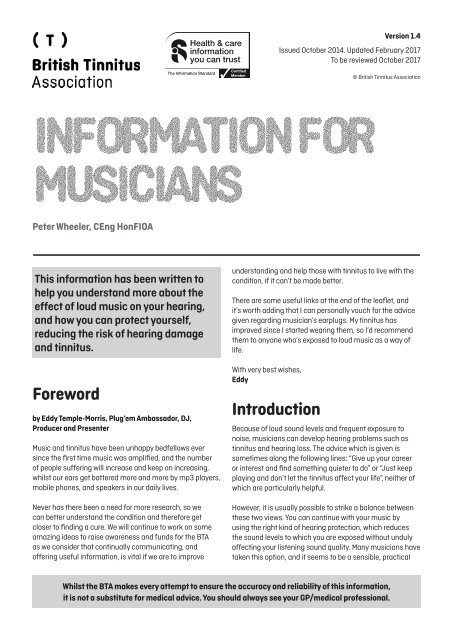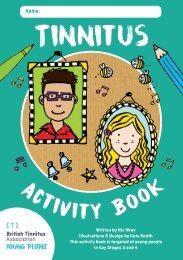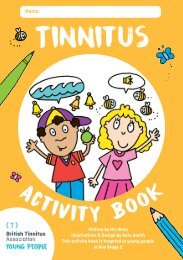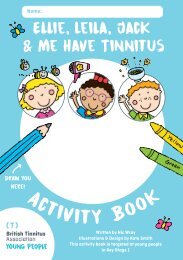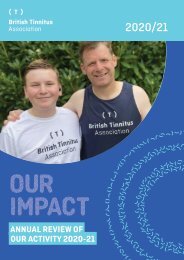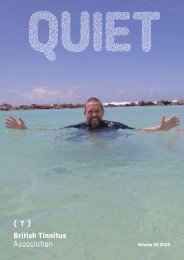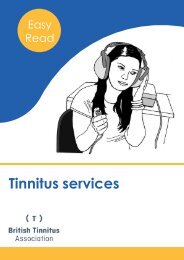Information for musicians Ver 1.4
Create successful ePaper yourself
Turn your PDF publications into a flip-book with our unique Google optimized e-Paper software.
<strong>Ver</strong>sion <strong>1.4</strong><br />
Issued October 2014. Updated February 2017<br />
To be reviewed October 2017<br />
© British Tinnitus Association<br />
INFORMATION FOR<br />
MUSICIANS<br />
Peter Wheeler, CEng HonFIOA<br />
This in<strong>for</strong>mation has been written to<br />
help you understand more about the<br />
effect of loud music on your hearing,<br />
and how you can protect yourself,<br />
reducing the risk of hearing damage<br />
and tinnitus.<br />
Foreword<br />
by Eddy Temple-Morris, Plug’em Ambassador, DJ,<br />
Producer and Presenter<br />
Music and tinnitus have been unhappy bedfellows ever<br />
since the first time music was amplified, and the number<br />
of people suffering will increase and keep on increasing,<br />
whilst our ears get battered more and more by mp3 players,<br />
mobile phones, and speakers in our daily lives.<br />
Never has there been a need <strong>for</strong> more research, so we<br />
can better understand the condition and there<strong>for</strong>e get<br />
closer to finding a cure. We will continue to work on some<br />
amazing ideas to raise awareness and funds <strong>for</strong> the BTA<br />
as we consider that continually communicating, and<br />
offering useful in<strong>for</strong>mation, is vital if we are to improve<br />
understanding and help those with tinnitus to live with the<br />
condition, if it can’t be made better.<br />
There are some useful links at the end of the leaflet, and<br />
it’s worth adding that I can personally vouch <strong>for</strong> the advice<br />
given regarding musician’s earplugs. My tinnitus has<br />
improved since I started wearing them, so I’d recommend<br />
them to anyone who’s exposed to loud music as a way of<br />
life.<br />
With very best wishes,<br />
Eddy<br />
Introduction<br />
Because of loud sound levels and frequent exposure to<br />
noise, <strong>musicians</strong> can develop hearing problems such as<br />
tinnitus and hearing loss. The advice which is given is<br />
sometimes along the following lines: “Give up your career<br />
or interest and find something quieter to do” or “Just keep<br />
playing and don’t let the tinnitus affect your life”, neither of<br />
which are particularly helpful.<br />
However, it is usually possible to strike a balance between<br />
these two views. You can continue with your music by<br />
using the right kind of hearing protection, which reduces<br />
the sound levels to which you are exposed without unduly<br />
affecting your listening sound quality. Many <strong>musicians</strong> have<br />
taken this option, and it seems to be a sensible, practical<br />
Whilst the BTA makes every attempt to ensure the accuracy and reliability of this in<strong>for</strong>mation,<br />
it is not a substitute <strong>for</strong> medical advice. You should always see your GP/medical professional.
way of dealing with the problem.<br />
Musicians should protect their hearing whilst playing.<br />
There are various reasons <strong>for</strong> this – <strong>for</strong> example, the risk<br />
of hearing damage, post-exposure tinnitus and loudness<br />
discom<strong>for</strong>t.<br />
Noise legislation<br />
If you are an employed musician, the Control of Noise<br />
at Work Regulations (2005), which implemented the<br />
EU Physical Agents Directive (Noise) in the UK, made<br />
employers responsible <strong>for</strong> the assessment, management<br />
and reduction of noise in the workplace, including the<br />
provision, where appropriate, of suitable hearing protection.<br />
The music and entertainment industry was allowed a threeyear<br />
period be<strong>for</strong>e the Regulations became effective in<br />
2008.<br />
So any employed musician should now have access to<br />
advice, suitable hearing protection and/or other <strong>for</strong>ms of<br />
noise reduction. But self-employed and amateur <strong>musicians</strong><br />
also need help and advice!<br />
Risk to hearing and noise<br />
reduction<br />
The risk to hearing from noise at work is dependent on the<br />
sound intensity (acoustic power). The safe exposure limit is<br />
calculated from a combination of exposure time and sound<br />
intensity. Reducing the noise level by only three decibels<br />
would allow a doubling of the exposure time, but this is not<br />
feasible <strong>for</strong> per<strong>for</strong>mances as controlling playing time is not<br />
really a very effective way of managing a musician’s noise<br />
exposure.<br />
Most international regulations <strong>for</strong> exposure at work state<br />
that the loudest noise someone should be exposed to <strong>for</strong> an<br />
eight hour working day is 85 decibels (dB) - see Table 1.<br />
Our leaflet Noise and the ear discusses noise dosage,<br />
identifying loud noise and the consequences of noise<br />
exposure in more detail - please contact us <strong>for</strong> a copy or<br />
visit our website www.tinnitus.org.uk<br />
Reducing the level of sound reaching the musician’s ear,<br />
whilst still providing a realistic listening environment, is the<br />
best way <strong>for</strong>ward <strong>for</strong> most people. A suitably chosen and<br />
correctly fitted flat attenuation earplug can be an effective<br />
solution, maintaining musical fidelity. In some cases,<br />
screens and sound absorbing surfaces can also play a part<br />
in managing noise exposure.<br />
Table 1: maximum exposure time <strong>for</strong> a range of noise<br />
intensities be<strong>for</strong>e damage may occur<br />
Noise<br />
intensity<br />
(dB)<br />
Maximum<br />
unprotected<br />
exposure*<br />
Typical example<br />
85 8 hours blender, milling machine<br />
88 4 hours <strong>for</strong>klift truck<br />
91 2 hours Tube train<br />
94 1 hour lawnmower<br />
97 30 minutes industrial fire alarm<br />
100 15 minutes bulldozer, handheld drill<br />
103 7½ minutes mp3 player at full volume<br />
106 3¾ minutes motorbike<br />
109 112 seconds crying baby, jackhammer<br />
112 66 seconds live rock band<br />
115 33 seconds emergency vehicle siren<br />
* be<strong>for</strong>e damage may occur<br />
Some people will develop permanent noise-induced<br />
hearing loss (NIHL) at moderate noise levels whilst others<br />
will not. Susceptibility to NIHL is predictable, so it is not<br />
possible to say whether an individual is at risk just by taking<br />
a hearing test. Saying “I have tough ears” is not a sensible<br />
approach to protecting your long-term hearing! And if you<br />
have NIHL, don’t say, “It’s too late <strong>for</strong> me”, it’s all the more<br />
important to protect your ears from even more damage and<br />
to try to avoid the onset of tinnitus.<br />
Musicians’ hearing<br />
protectors<br />
A wide range of technical ear protection products are<br />
available. Effective earplugs will reduce the overall level of<br />
sound whilst maintaining an even balance across the sound<br />
spectrum. This means that you can still hear everything<br />
clearly, although the overall sound level is reduced. The<br />
greater the number of decibels (dBs) of attenuation by the<br />
ear plugs, the better overall protection they offer.<br />
Whilst there are a number of generic earplugs available are<br />
aimed at <strong>musicians</strong> (and stocked by the BTA), customised<br />
earplugs may provide a higher level of protection as well as<br />
better fidelity of sound. They tend to be more expensive but<br />
Whilst the BTA makes every attempt to ensure the accuracy and reliability of this in<strong>for</strong>mation,<br />
it is not a substitute <strong>for</strong> medical advice. You should always see your GP/medical professional.
should be looked upon as an investment.<br />
A number of companies manufacture specialist hearing<br />
protectors and in-the-ear monitors <strong>for</strong> <strong>musicians</strong>.<br />
Essentially, <strong>musicians</strong>’ earplugs are either based upon<br />
an earplug incorporating a “tuned” mechanical filter set<br />
to provide a flat frequency response and some reduction<br />
in intensity, or a fusion of hearing protection and digital<br />
hearing aid technology. In the latter devices, the sound level<br />
at the ear may be controlled by a level-dependent amplifier<br />
and the frequency response of the system can be tailored<br />
to suit the wearer’s audiogram. These ear plugs may also be<br />
used by anyone who wishes to reduce the sound levels to<br />
which they are exposed without having muffled or distorted<br />
hearing.<br />
A decent amplifier or instrument can cost a considerable<br />
amount, so spending a smaller sum protecting your<br />
hearing, without impeding your playing too much, seems a<br />
reasonable outlay.<br />
If you wish to find out more about <strong>musicians</strong>’ earplugs the<br />
best option is to discuss your requirements with a qualified<br />
audiologist.<br />
Table 2 A comparison of some sounds (based on S.Everton 2006)<br />
dB<br />
160<br />
150 INTOLERABLE<br />
140<br />
Live rock band 130 PAIN<br />
High hat symbol strike 120<br />
Full symphony orchestra 110<br />
Bar in nightclub fff 100<br />
Chamber music in small<br />
auditorium<br />
Loud radio<br />
Normal piano practice<br />
ff 90 LOUD<br />
f<br />
mf<br />
80<br />
70<br />
140dB Peak Exposure Limit Value<br />
VERY NOISY<br />
Soft radio in home p 60 MODERATE<br />
Background TV studio pp 50 QUIET<br />
Quiet office 40<br />
ppp 30 FAINT<br />
20<br />
Rustle of leaves 10 VERY FAINT<br />
0<br />
Threshold of hearing<br />
85dB Upper Exposure Action Value<br />
80dB Lower Exposure Action Value<br />
Consequences<br />
Exposure to loud noise can have consequences <strong>for</strong> your<br />
ears, the most obvious of which is hearing loss. If noise<br />
is the suspected cause, this is termed noise-induced<br />
hearing loss. Exposure to loud noise can damage the hair<br />
cells in your cochlea, resulting in a hearing loss at certain<br />
frequencies.<br />
The hearing loss can be temporary, and recover within<br />
a day or two, or permanent, and not recover at all. Even<br />
if the hearing loss is temporary, it should be taken as a<br />
warning that permanent damage is likely if this exposure<br />
is repeated. Such hearing loss makes it harder to hear the<br />
quieter sounds encountered in daily life, and can make it<br />
harder to understand speech, particularly in background<br />
noise. There is also evidence that noise exposure can<br />
damage the nerve fibres that go from the cochlea to the<br />
brain, and that this damage doesn’t necessarily show up in<br />
hearing tests such as an audiogram.<br />
In addition to hearing loss, there are other risks from loud<br />
noise exposure. Loud noise exposure can sometimes cause<br />
a ringing or buzzing in the ears called tinnitus. Sometimes<br />
tinnitus goes away after a few minutes or hours after a<br />
loud noise exposure. However, sometimes it can persist <strong>for</strong><br />
weeks, years, or even indefinitely, especially if you have a<br />
noise-induced hearing loss.<br />
To avoid such damage, simple steps can be taken to reduce<br />
the risk posed by loud noise exposure.<br />
Other sources of noise<br />
As the impact of noise or loud levels of sound on the ear<br />
is accumulative, do not <strong>for</strong>get that there are a variety of<br />
other sources of noise or loud sounds that may need to<br />
be taken into account when considering the level of noise<br />
to which you are exposed. Those who use firearms, motor<br />
cycles, power tools or other devices that produce loud levels<br />
of sound should protect their ears when doing so. These<br />
different types of sound exposure all require different types<br />
of protection. For example, <strong>musicians</strong>’ earplugs are not<br />
suitable <strong>for</strong> someone who wishes to use a shotgun. Again, if<br />
you have any doubts, please consult an audiologist.<br />
Further resources<br />
A good source of in<strong>for</strong>mation <strong>for</strong> <strong>musicians</strong> is the US charity<br />
HEAR (Hearing Education and Awareness <strong>for</strong> Rockers). Their<br />
Whilst the BTA makes every attempt to ensure the accuracy and reliability of this in<strong>for</strong>mation,<br />
it is not a substitute <strong>for</strong> medical advice. You should always see your GP/medical professional.
advice is helpful <strong>for</strong> all <strong>musicians</strong>, not only rockers: www.<br />
hearnet.com<br />
More in<strong>for</strong>mation and a comprehensive guide are available<br />
from the Health and Safety Executive (HSE) website: www.<br />
hse.gov.uk/noise/musicsound.htm<br />
The HSE also have a number of leaflets and more<br />
comprehensive guides to download:<br />
Mythbuster: Noise in music and entertainment sectors<br />
www.hse.gov.uk/noise/mythaug07.pdf<br />
Sound advice: Control of noise at work in music and<br />
entertainment<br />
www.hse.gov.uk/pubns/books/hsg260.htm<br />
The Sound Advice website from the HSE is well presented<br />
with many practical tips <strong>for</strong> <strong>musicians</strong> of all kinds, and <strong>for</strong><br />
venues too: www.soundadvice.info/<br />
The Plug’em website from the BTA has in<strong>for</strong>mation on<br />
hearing protection <strong>for</strong> <strong>musicians</strong> and music lovers: www.<br />
plugem.co.uk<br />
References<br />
A list of the references consulted in preparing this leaflet is<br />
available on request.<br />
Alternative <strong>for</strong>mats<br />
This publication is available in large print on request.<br />
For further in<strong>for</strong>mation<br />
Our helpline staff can answer your questions on any tinnitus<br />
related topics on 0800 018 0527. You may also find our<br />
website takeontinnitus.co.uk helpful.<br />
BTA publications<br />
Our in<strong>for</strong>mation leaflets are written by leading tinnitus<br />
professionals and provide accurate, reliable and<br />
authoritative in<strong>for</strong>mation which is updated regularly.<br />
Please contact us if you would like to receive a copy of<br />
any of our in<strong>for</strong>mation leaflets listed below, or they can be<br />
downloaded from our website. *available in Easy Read<br />
• All about tinnitus*<br />
• Balance and tinnitus<br />
• Complementary therapy <strong>for</strong> tinnitus: an opinion<br />
• Drugs and tinnitus<br />
• Ear wax removal and tinnitus<br />
• Flying and the ear<br />
• Food, drink and tinnitus<br />
• Hearing aids and tinnitus*<br />
• Hyperacusis<br />
• Ideas <strong>for</strong> relaxation without sound<br />
• <strong>In<strong>for</strong>mation</strong> <strong>for</strong> <strong>musicians</strong><br />
• Musical hallucination (musical tinnitus)<br />
• Noise and the ear<br />
• Otosclerosis<br />
• Pulsatile tinnitus<br />
• Relaxation<br />
• Self help <strong>for</strong> tinnitus*<br />
• Sound therapy<br />
• Sources of mutual support <strong>for</strong> tinnitus<br />
• Supporting a child with tinnitus in the classroom<br />
• Supporting someone with tinnitus<br />
• Taming tinnitus<br />
• Tinnitus and disorders of the temporomandibular<br />
joint (TMJ) and neck<br />
• Tinnitus and sleep disturbance<br />
• Tinnitus and stress<br />
• Tinnitus services*<br />
Leaflets <strong>for</strong> children:<br />
• Ellie, Leila and Jack have tinnitus (<strong>for</strong> under 8s)<br />
• Tinnitus (<strong>for</strong> 8-11 year olds)<br />
• Tinnitus (<strong>for</strong> 11-16 year olds)<br />
• Ellie, Leila and Jack have tinnitus activity book (<strong>for</strong><br />
under 8s)<br />
• Tinnitus activity book (<strong>for</strong> 8-11 year olds)<br />
• Tinnitus activity book (<strong>for</strong> 11-16 year olds)<br />
British Tinnitus Association<br />
Ground Floor, Unit 5, Acorn Business Park, Woodseats Close, Sheffield S8 0TB<br />
Email: info@tinnitus.org.uk<br />
Helpline: 0800 018 0527<br />
Website: tinnitus.org.uk<br />
The British Tinnitus Association. Registered charity no: 1011145 Company limited by guarantee no: 2709302. Registered in England. This in<strong>for</strong>mation has<br />
been produced by the BTA and con<strong>for</strong>ms to the Principles and Requirements of the <strong>In<strong>for</strong>mation</strong> Standard.<br />
Whilst the BTA makes every attempt to ensure the accuracy and reliability of this in<strong>for</strong>mation,<br />
it is not a substitute <strong>for</strong> medical advice. You should always see your GP/medical professional.


